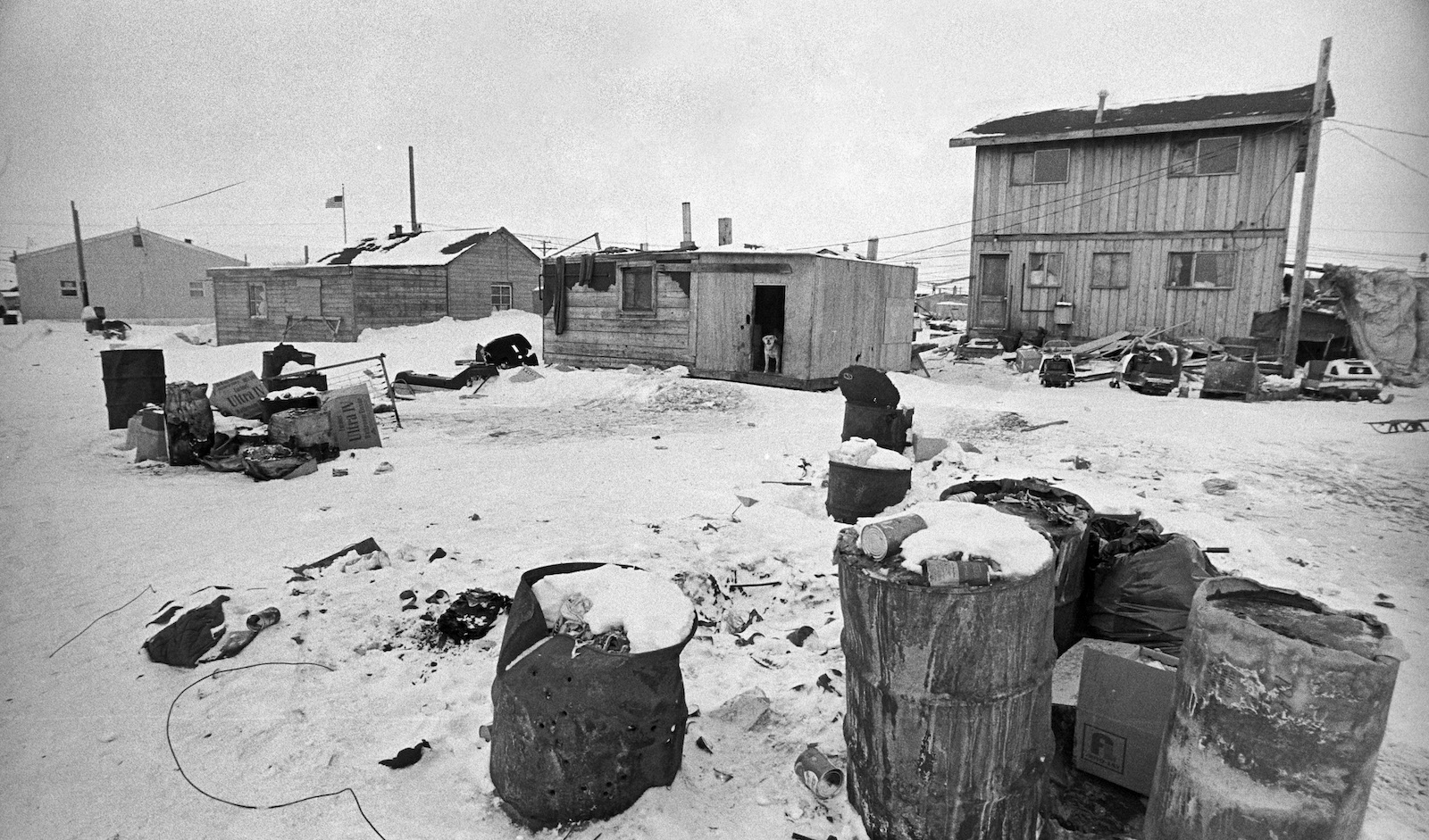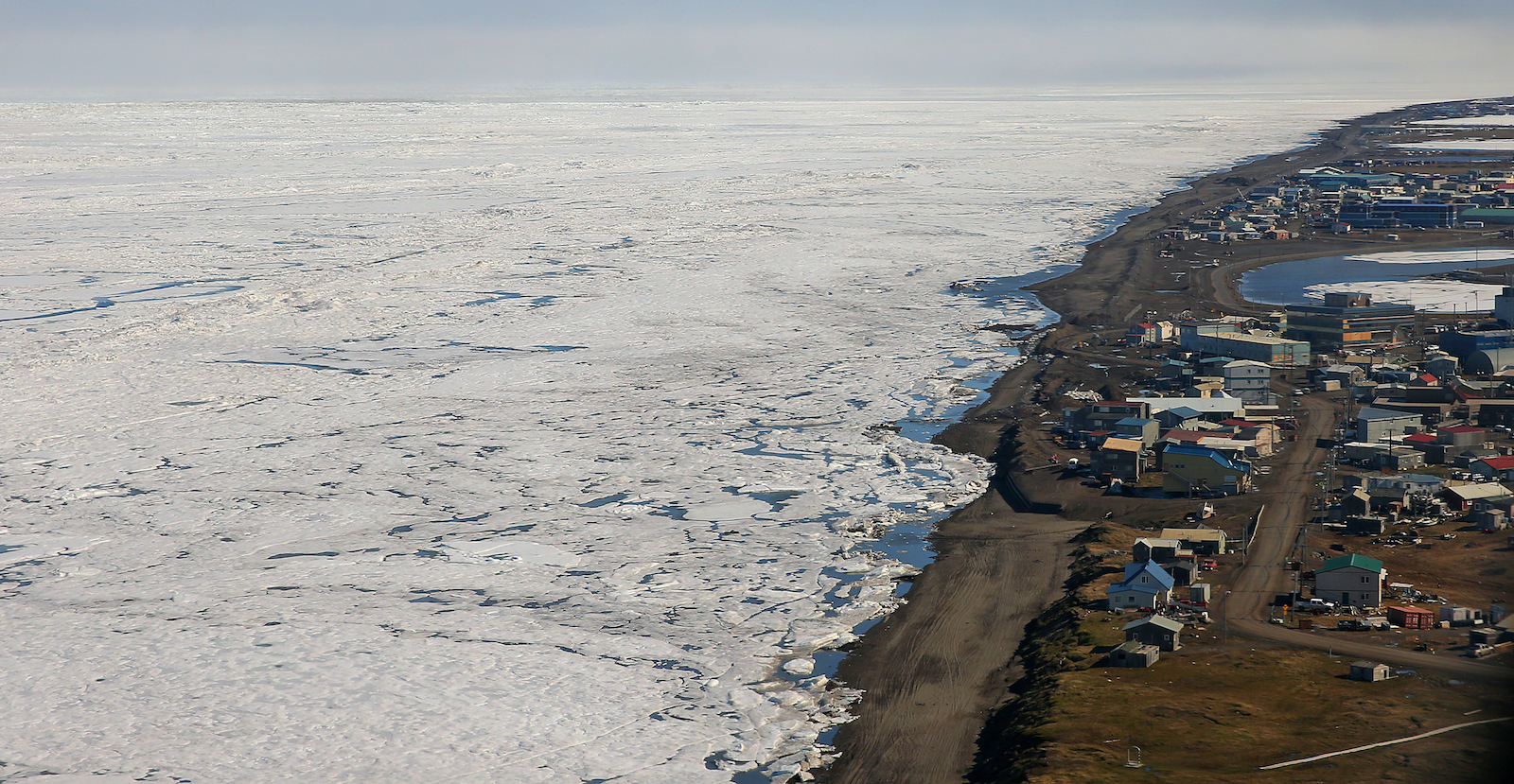This story was originally published by High Country News and is reproduced here as part of the Climate Desk collaboration.
Utqiagvik sits at the very tip of the United States, saddled against the Arctic Ocean. The Alaska Native Inupiat are set apart from other Indigenous peoples by their subsistence hunting of the bowhead whale. Even today, this unique, centuries-old practice determines the social structure, reflects community values, and supplements the people’s nutrient-rich diet. Nearly all of Utqiagvik’s roughly 5,000 residents, the majority of whom are Inupiat, rely on hunting to support their way of life.
Which is why Harry Brower Jr., an Inupiaq whaling captain and Arctic Alaska mayor, finds it odd when outsiders try to explain things to him.
“I’m reading about this research on bowhead whales in different countries,” he told me one afternoon in February. I met Brower in a mahogany-clad office decorated with relics of his hometown: mounted walrus tusks, paintings of icebergs at sea, and a portrait of Brower and Utqiagvik’s first mayor, Eben Hopson, standing with other community members under “the Gateway to the Arctic” — two huge whale bones arranged in a dramatic arch.
“Here are two words I read about this morning,” he said, pointing to a yellow Post-it on his desk inscribed with the words “hyperboreus” and “parsimonious.” Until he Googled the term, Brower didn’t know what it meant, though he is, in fact, a hyperborean: an inhabitant of the Far North. “(Scientists) all speak a different language,” he said. “They do.”
While serving as mayor of the North Slope Borough, which encompasses eight separate communities and about 10,000 people, Brower also chaired the Alaska Eskimo Whaling Commission. The AEWC was formed in 1977, after the federal government, worried about low bowhead whale numbers in the Bering Sea, banned the Inupiat’s subsistence hunt. In response, local whalers conducted their own census, which proved that the whales were being undercounted by the thousands when they swam underneath the ice. The Inupiats’ research resulted in an increased quota. This anecdote is a well-worn story in Utqiagvik — formerly known as Barrow — a point of pride marking a time the Inupiat bested the federal government by showing more precise knowledge of their lands and waters.
In the last two centuries, the climate has been severely altered by human forces. But it has always been changing in some form here, according to the Inupiat. Evidence of past ecosystem shifts is preserved in the great tusks of a mammoth found in the perennially frozen earth and in the oral histories repeated like mantras. The term “climate change” strikes a different tone up here.
Life below 0 degrees F has always been challenging, so the Inupiat story is defined by adaptation. When the mammoth became extinct, the Inupiat adapted. When Western influences crept north, the Inupiat replaced their dogsleds with snow machines, their seal oil lamps with electricity. Today, the Arctic is warming at twice the global average, necessitating a new era of adjustments in life on land and sea. The weaker sea ice endangers hunters, while melting soil threatens homes and city infrastructure. The encroaching sea is eating away at the shoreline.
“What other choice do we have?” Kaare Sikuaq Erikson, an Inupiaq science liaison at the village corporation, said. “People assume that we’re entering this new Arctic, when in reality we have faced adversity for thousands of years. We’ve always been able to adapt and be resilient. This is no different.”
The Arctic — “ground zero for climate change” — is warming more rapidly than the rest of the planet because of a positive feedback loop called Arctic amplification. Rising global temperatures melt the reflective surfaces of snow and ice each year, exposing the darker areas they cover, and the open water and bare ground absorb sunlight, rather than reflect it. This absorbed light creates heat, melting more snow and ice.
Last year, temperatures in Utqiagvik and the state of Alaska broke the federal government’s 120-year record. The shift has happened so quickly in the North that it has outrun the research tools used to measure it. In 2017, it changed so fast that the National Oceanic and Atmospheric Administration warned scientists that the data was potentially flawed. But the data proved accurate: It was the area’s warmest recorded temperature to date.
“Nobody disputes that things change,” Alaska climatologist Rick Thoman said. “The question is: Why are they changing now? Why aren’t there mammoths on the North Slope now? You can’t answer the question without invoking greenhouse gases. From a Western science perspective, that is the only conclusion.”
The Arctic has lost 641,000 square miles of sea ice in the month of March alone — an area roughly the size of Alaska, according to National Snow and Ice Data Center records. Warmer temperatures also make for a later freeze and an earlier breakup of the ice, shrinking the time frame for spring whaling.
Whaling is the pinnacle of Inupiat culture and the subsistence lifestyle. It takes place in spring and fall, when bowhead whales migrate past Utqiagvik. Inupiat hunters say the whales “give themselves” to worthy hunters, so preparation is year-round and meticulous. Women carefully craft sealskin boats, sewn together with caribou tendon, and whaling crews clean out their ice cellars. Community members store whale and other raw meats in traditional belowground refrigerators dug about 20 feet into permafrost. (Both climate change and urban development are now causing some cellars to thaw, spoiling the meat.)

One of the three California gray whales surfaces in a breathing hole cut into the ice off Point Barrow during a rescue attempt in October 1988. Bill Roth / Anchorage Daily News / MCT / Getty Images
Each spring, hunters use ice picks to build trails over frozen sea ice. Once the paths are smoothed, they drive snowmobiles several miles to reach open water. At the ice’s edge, they assemble camps, then wait for a bowhead to pass. As soon as a whale is spotted, the crews slide their sealskin boats into the water, and a crewmember attempts to harpoon the animal. When a whale is struck, the captains signal other crews by VHF radio. Other hunters rally to the boat, and everyone pulls the whale onto the ice shore.
But landing a bowhead has become increasingly dangerous: Each whale weighs up to 120,000 pounds and must be pulled onto the less stable sea ice.
Inupiak brothers Jack and Brower Frantz are co-captains on their uncle’s whaling crew, having risen through the ranks since they were teenagers. “When we were growing up, it always seemed like the ice was a constant,” Jack said. “We always knew it was going to be good. The last five years, it just seems like it’s hit or miss.”
Brower Frantz, now 34, remembers the long snowmobile ride to the ice edge, roughly 15 miles from the shore. When he was a teenager, it took more than two hours. “I felt safe driving out there by myself, and I was just a kid,” he said. Now, the ice frequently breaks off within a quarter-mile of the shore, making the past five years the most unsafe he’s experienced.
On land, Utqiagvik residents face a different but related instability underfoot: permafrost thaw. Last summer, Utqiagvik endured the wettest summer on record, with twice as much rainfall as usual. Rain thawed the ground several feet deeper than normal, past the “active” layer of permafrost, which is normally frozen year-round. During freeze-up, the infrastructure built into the usually immobile permafrost — water lines, telephone poles and house pilings — all began pushing up out of the ground. Now, utility poles tilt at worrisome angles, and some homes appear to be teetering on stilts.
Bill Tracey, a local assemblyman who represents Point Lay, a village about 200 miles southwest of Utqiagvik, said the thaw there is so bad that once-narrow crawlspaces under the homes can now hold ATVs.
“The biggest change is that it’s gotten so warm that the permafrost is thawing so far down that all of the pipes are moving a lot and breaking,” said Yves Brower, Harry Brower’s second cousin, who heads the water and sewer department in Utqiagvik. He is acutely aware of the impacts of the changing climate: The week we spoke, nine different water pipes broke, spouting like geysers out of various paved roads.
Not all of Utqiagvik’s pipes are buried in the permafrost. The majority are housed in a utilidor, a 3-mile-long tunnel of water, sewer, and electrical pipes. The utilidor — which cost $800 million, funded almost entirely by oil money — is Utqiagvik’s single most valuable asset. It helped bring the borough into the 21st century. Before it was built, in the 1980s, most residents hauled ice in for water and used “honey buckets” for sewage.
In the late 1960s, the largest oilfield in North America was discovered on Inupiat land, 200 miles east of Utqiagvik. The Inupiat lobbied to form the North Slope Borough. Once they had an incorporated government, they were able to collect property taxes from oil and gas infrastructure built on their land. Ever since, that money has made up the majority of the North Slope Borough’s property tax revenue. Last year, it came to $377 million, borough financial director Sandra Stuermer said.
Oil money not only afforded the North Slope the construction of the kind of infrastructure most of America had enjoyed for the past 100 years, it also provided the funds necessary to maintain it in harsh conditions — conditions exacerbated, ironically, by climate change. Today, the money generated from property taxes pays for all borough operations, including the state and federal bond debts for maintenance of infrastructure in all eight villages.
“Barrow has been lucky,” Yves Brower said. Like most locals, he still refers to his town by the name a British whaling officer gave it in the 1800s, rather than using its Native name, which the village voted to return to in 2016. “We’ve been really wealthy from our oil money.”
For many here, oil money represents opportunity and autonomy. In 2018, the median household income of North Slope Borough residents was $75,431. Many are grateful for the wealth, even as the greenhouse gases emitted by fossil fuel use continue to warm the Arctic. Now, however, the Inupiat are facing yet another challenge: the potential shift of the global economy away from those fossil fuels.
In December, citing climate change, Goldman Sachs announced it would stop financing new oil exploration in the Arctic. A number of other banks followed suit. Mayor Harry Brower penned an editorial for the Wall Street Journal, condemning the investment bank for claiming stakeholder engagement as a core business principle while failing to consult the people of the North Slope.
“The way we see it, caring about the land and wildlife should also mean caring about the Indigenous people who inhabit the land,” he wrote. “We aren’t hungry for oil, we are hungry for progress and understanding from those on the East Coast and beyond. We don’t need your protection or judgment. We need your respect. We need to be treated like fellow Americans.”

View of garbage frozen in late-winter snow, along with Eskimo homes, Barrow, Alaska, April 1973. Spencer Grant / Getty Images
Today, as ice conditions worsen, whalers are finding new hunting methods, using technological improvements that help keep hunters safe in the risky work they do to feed their communities. As technology improves, the Inupiat adapt.
The University of Alaska Fairbanks has mapped out hunters’ trails to whaling camps, for example, and this research has become an increasingly valued tool for contemporary hunters. Matthew Druckenmiller, who developed it, is now a research scientist at the National Snow and Ice Data Center. In partnership with whaling crews, the borough and local whale biologist Craig George, Druckenmiller used GPS navigation to map the trails from 2008 to 2011. The project, which was inspired by an elder’s attempt to hand-draw maps years earlier, overlaid GPS trail locations with surveys of ice thickness and with satellite imagery showing the general type of ice and its extent. The resulting maps are distributed throughout the community during hunting season. Whaler Jack Frantz said the maps are regarded as helpful and educational for the younger hunters who haven’t spent years studying ice conditions.
Though Druckenmiller’s student research ended in 2011, he continues the study every year. Whalers use the map data to direct others to their camps to help drag whales onto the ice for butchering. Druckenmiller calls the information “supplemental” to whaling crews’ traditional practices. “To be resilient to the environment relies on having multiple tools at your disposal,” he said. “This is just one of them.”
Previously, hunters sometimes struggled to locate trails in the vast expanse of tundra, said Bernice Oyagak, an Inupiaq whaler. “Now, it’s cool, because (they) send us a map and they say, ‘Here’s their trail,’ ” she said. The map also shows ice thickness, making it “kind of scary to know when you’re driving over a mere two feet of ice,” she said. “But I guess it’s better to know it than to not know it, because you’re hauling back so many pounds of meat. It can be dangerous out there.”
The work of adaptation never ends. Now, as increasingly tough whaling years leave freezers empty, the Inupiat hunt more caribou. With coastal erosion eating away several feet of beach each year, the borough is seeking federal and state bonds to build a $300 million seawall. When the drinking water lagoon become polluted, the city put in place infrastructure to collect snowmelt that now runs through spigots. And now that permafrost thaw and coastal erosion threaten homes, a local housing authority is building adjustable homes on sleds. The Inupiat adapt, bearing the brunt of global climate change — a harbinger of what’s to come in a world that remains stubbornly reliant on fossil fuels.
“We’re taking on all the risks because of these global and environmental changes that are occurring,” Brower said. “We’ve endured the train wreck. The train wreck is here. Everything is spilled all over the ground, and we’re just looking at it and trying to figure out: What do we do now? Who’s responsible? Now we have to deal with it.”
Still, the Inupiat remain undaunted by an unknown future. “We have to to be a survivalist here in the Arctic,” Brower said. “We’re strong. We can survive.”



